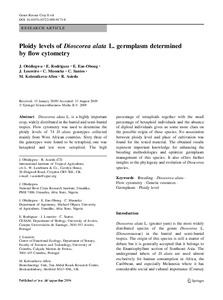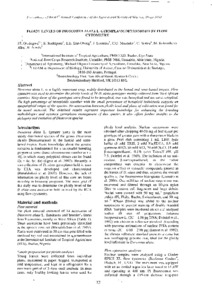| dc.contributor.author | Obidiegwu, J.E. |
| dc.contributor.author | Rodríguez, E. |
| dc.contributor.author | Ene-Obong, E.E. |
| dc.contributor.author | Loureiro, J. |
| dc.contributor.author | Muoneke, C. |
| dc.contributor.author | Santos, C. |
| dc.contributor.author | Kolesnikova-Allen, M. |
| dc.contributor.author | Asiedu, Robert |
| dc.date.accessioned | 2019-12-04T11:11:47Z |
| dc.date.available | 2019-12-04T11:11:47Z |
| dc.date.issued | 2009 |
| dc.identifier.citation | Obidiegwu, J., Rodriguez, E., Ene-Obong, E., Loureiro, J., Muoneke, C., Santos, C., ... & Asiedu, R. (2010). Ploidy levels of Dioscorea alata L. germplasm determined by flow cytometry. Genetic Resources and Crop Evolution, 57(3), 351-356. |
| dc.identifier.uri | https://hdl.handle.net/20.500.12478/2498 |
| dc.description | published online: 08 Sept 2009 |
| dc.description.abstract | Dioscorea alata L. is a highly important crop, widely distributed in the humid and semi-humid tropics. Flow cytometry was used to determine the ploidy levels of 74 D. alata genotypes collected mainly from West African countries. Sixty three of the genotypes were found to be tetraploid, one was hexaploid and ten were octoploid. The high percentage of tetraploids together with the small percentage of hexaploid individuals and the absence of diploid individuals gives us some more clues on the possible origin of these species. No association between ploidy level and place of cultivation was found for the tested material. The obtained results represent important knowledge for enhancing the breeding methodologies and optimize germplasm management of this species. It also offers further insights to the phylogeny and evolution of Dioscorea species. |
| dc.description.sponsorship | Kirkhouse Trust |
| dc.format.extent | 351-356 |
| dc.language.iso | en |
| dc.subject | Breeding |
| dc.subject | Dioscorea Alata |
| dc.subject | Flow Cytometry |
| dc.subject | Genetic Resources |
| dc.subject | Germplasm |
| dc.subject | Ploidy Level |
| dc.title | Ploidy levels of Dioscorea alata L. germplasm determined by flow cytometry |
| dc.type | Journal Article |
| dc.description.version | Peer Review |
| cg.contributor.affiliation | International Institute of Tropical Agriculture |
| cg.contributor.affiliation | National Root Crops Research Institute, Nigeria |
| cg.contributor.affiliation | Michael Okpara University of Agriculture |
| cg.contributor.affiliation | University of Aveiro |
| cg.contributor.affiliation | University of Coimbra |
| cg.contributor.affiliation | Tun Abdul Razak Research Centre |
| cg.coverage.region | Africa |
| cg.coverage.region | West Africa |
| cg.coverage.region | Central Africa |
| cg.coverage.country | Benin |
| cg.coverage.country | Congo |
| cg.coverage.country | Cote D'Ivoire |
| cg.coverage.country | Ghana |
| cg.coverage.country | Nigeria |
| cg.coverage.country | Sierra Leone |
| cg.coverage.country | Togo |
| cg.isijournal | ISI Journal |
| cg.authorship.types | CGIAR and developing country institute |
| cg.iitasubject | Yam |
| cg.iitasubject | Plant Breeding |
| cg.iitasubject | Plant Genetic Resources |
| cg.journal | Genetic Resources and Crop Evolution |
| cg.howpublished | Formally Published |
| cg.accessibilitystatus | Limited Access |
| local.dspaceid | 93249 |
| cg.identifier.doi | https://dx.doi.org/10.1007/s10722-009-9473-8 |


